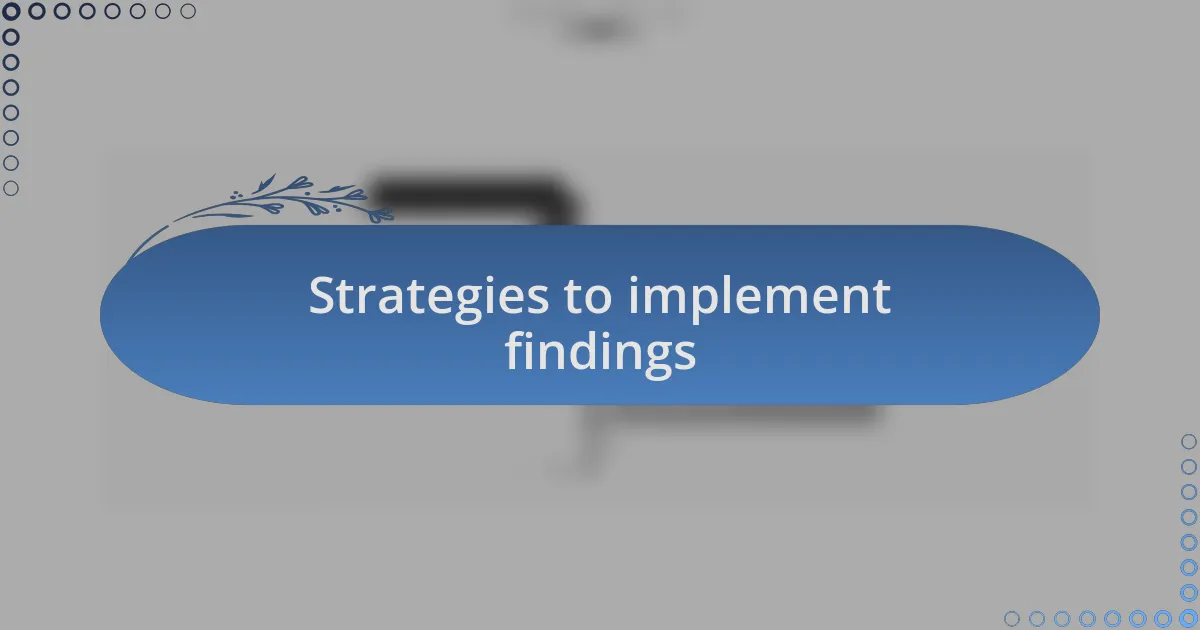Key takeaways:
- Competitor analysis reveals valuable insights into strengths, weaknesses, and market trends, helping businesses identify growth opportunities.
- Key areas for analysis include website design, content strategy, and pricing models, which can significantly impact user engagement and conversion rates.
- Using tools like SEMrush, SimilarWeb, and Google Alerts can enhance competitor analysis, providing data-driven insights to inform strategic decisions.
- Implementing findings from competitor analysis can lead to improved user experience, enhanced social media engagement, and innovative service offerings.

Understanding competitor analysis
Competitor analysis is essentially a strategic tool that helps you comprehend the strengths and weaknesses of rival businesses in your niche. I remember the first time I dove into this kind of analysis; I was amazed at how much insight I gained from just observing their websites. It was as if a light bulb went off—did I really know my audience as well as I thought I did?
When I analyze competitors, I look beyond their services to scrutinize their content, user engagement, and online presence. This practice allowed me to identify gaps in my offerings that I hadn’t noticed before. Have you ever considered how much those tiny details can shape your brand’s success? Trust me; understanding these nuances can be a game changer.
What’s especially intriguing is seeing how competitors position themselves in the market. I used to compare my website with theirs constantly, but over time, I learned to appreciate their tactics and even adopt some that resonated with my style. It made me wonder—if we can learn so much from competitors, how can we turn our key takeaways into unique selling propositions?

Importance of competitor analysis
Competitor analysis is crucial because it unveils opportunities that may not be obvious at first glance. I recall a time when a simple review of a competitor’s pricing structure led me to reconsider my own pricing strategy. They offered a tiered model that appealed to different customer segments, and it made me think—how might I adjust my offerings to cater to a broader audience?
Another significant aspect of competitor analysis is understanding market trends. By keeping an eye on what others are doing, I discovered emerging customer needs that I hadn’t previously identified. It sparked a collaborative project within my team where we brainstormed ways to innovate our services. I often ask myself, how can we stay ahead if we aren’t aware of shifting expectations in our industry?
Lastly, competitor analysis fosters a culture of continuous improvement. I’ve found that reflecting on what competitors excel at can motivate me to push my boundaries. Sometimes, when I feel complacent, I revisit my competitive landscape. It’s like a gentle nudge reminding me that there’s always room for growth—are you ready to embrace that challenge?

Key areas to analyze
Analyzing a competitor’s website design is pivotal. I remember once stumbling upon a competitor that used engaging visuals and a user-friendly layout, which made their services pop in a way mine didn’t. I asked myself, how could I reimagine my site to enhance the user experience? This led me down a path of exploring interactive elements and better navigation, ultimately boosting my own site’s engagement rates.
Content strategy is another critical area to examine. Observing how competitors craft their messaging can be enlightening. For instance, I noticed that one rival had a knack for storytelling that resonated with visitors. After analyzing their approach, I began to weave more narratives into my own content, inviting potential clients into my journey and making my offerings feel more relatable. Have you thought about how your storytelling could connect with your audience?
Lastly, pricing models demand close scrutiny. I once discovered that a competitor offered flexible payment options that significantly increased conversions. Inspired by this, I revisited my own structure to introduce similar options, resulting in higher client acquisition. It made me wonder, how flexible are you willing to be to meet your customers’ needs? Identifying these gaps can be a game-changer in positioning your services effectively.

Tools for competitor analysis
When it comes to tools for competitor analysis, I’ve found that platforms like SEMrush and Ahrefs are invaluable. They offer a wealth of data on competitors’ keywords, backlinks, and traffic sources. I remember using SEMrush to uncover a competitor’s top-performing blog posts, which inspired me to refine my content strategy.
Another tool that I often recommend is SimilarWeb. It provides insight not only into website traffic but also audience demographics. This was a game changer for me; by identifying where my audience came from, I adjusted my marketing efforts accordingly. Have you considered how understanding your audience’s interests could reshape your approach?
Lastly, I can’t overlook Google Alerts. Setting alerts for my competitors allowed me to stay informed about their latest moves. I distinctly recall receiving alerts about a new service they launched, which prompted me to assess my offerings. Are you keeping an eye on the competition to seize opportunities as they arise? These small insights can lead to significant improvements in our strategies.

My personal insights gained
Through my journey in competitor analysis, I’ve realized how essential it is to view a competitor’s strengths and weaknesses objectively. For instance, while studying a rival’s website, I discovered they had a user-friendly design coupled with compelling calls-to-action. This made me reflect on my own website’s layout and sparked a desire to enhance user experience. Have you ever felt that push to elevate your own standards after seeing someone excel?
One particularly eye-opening moment came when I examined a competitor’s engagement on social media. Their way of interacting with followers was so genuine and relatable that it inspired me to inject a bit more personality into my communications. It’s fascinating how a simple tweak in tone and approach can foster a deeper connection with the audience. Have you considered how your voice can help build a community around your brand?
Lastly, competitor pricing strategies offered me a new perspective on my own service offerings. I realized that my pricing didn’t reflect the value I was providing, and after careful analysis, I adjusted my rates to better align with market trends. This not only boosted my confidence but also created an opportunity for increased customer satisfaction. Have you ever played with pricing strategies and noticed a shift in client perception?

Strategies to implement findings
To effectively implement findings from competitor analysis, I started by prioritizing the aspects that directly impact user experience on my site. For example, after recognizing my competitor’s streamlined navigation, I took the plunge to reorganize my website’s menu, making it simpler for users to find what they needed quickly. Have you considered how a small change in layout could enhance usability and keep visitors engaged longer?
Next, I experimented with enhancing my social media strategy by adopting a more authentic tone in my posts. Reflecting on those competitor interactions, I crafted posts that feel less scripted and more conversational—like having a chat with a friend. I found that this not only elevated engagement but also made my audience feel more connected to my brand. How might you approach your social media conversations differently to draw your audience in?
Finally, I adjusted my service package structures based on what I learned about competitor offerings. By introducing tiered pricing that highlighted the added value at each level, I found clients were more enthusiastic about selecting higher-tier services. This experience taught me that understanding your competition isn’t just about imitation; it’s about innovating your offerings to create something unique and appealing. Have you thought about how your packages might need to evolve to appeal to customer needs better?

Enhancing web development services
By leveraging insights gained from competitor analysis, I realized the importance of optimizing my web development services for mobile users. In a recent project, I encountered a challenge where mobile visitors struggled with my site’s load time. After assessing competitors, I implemented faster loading techniques, which significantly reduced bounce rates. Have you ever considered how critical site speed can be to the mobile experience?
Focusing on client feedback, I decided to enhance my development process by introducing more frequent check-ins. Inspired by a competitor’s approach, I scheduled bi-weekly progress updates. This not only alleviated client anxiety but also fostered a deeper collaborative spirit. Have you thought about how open communication could strengthen your client relationships?
I also found that diversifying my service offerings led to significant improvements in client attraction. After observing how competitors bundled services creatively, I introduced combined packages that included everything from initial design to ongoing maintenance. It felt rewarding to watch clients respond positively, knowing I was not just offering a service but crafting a solution. How might diversifying your services create more value for your customers?